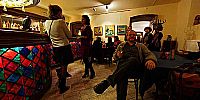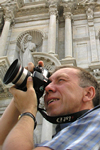
Restaurant of The Stray Dog Club
Saint Petersburg, Russia
December 4, 2008, 15:58 UTC (18:58 local time)
© 2008 Andrew Varlamov, All Rights Reserved.
In 1915, The Stray Dog was closed because of financial difficulties.
There was no question of reviving The Stray Dog during the Soviet period, although it was used as a bomb shelter during the Leningrad blockade. However, in the more tolerant climate of perestroika, local artists began to talk of reopening the place, with Andrei Moguchy and his Formal Theater giving several performances on the old premises, and artist Eduard Kochergin holding exhibitions there. Proper reconstruction of the place was finally finished in 2000, and at last The Stray Dog was officially opened in February, 2001 in the basement of the Mussorgsky Theater, where it was originally located.
"We don't want to turn it into a museum," says Vladimir Sklarsky, the Director of The Stray Dog. "We realise that it's impossible to step in the same river twice. It's also impossible to revive the former atmosphere. Times have changed. What we want is to breath new life into the place and make a bridge across time."
The Stray Dog is comfortable and spacious, with its own exhibition hall, an area for theater performances and concerts and a small restaurant. The reconstruction was supervised by architect Jean Verzhbitsky, while Kochergin, who is well known for his work in the Bolshoy Drama Theater, designed the interior. The perfomance area has an important feature, in that it is can be easily adapted to the needs of a jazz concert, performance or a lecture.
"The aim of The Stray Dog today," says Vladimir Sklyarsky, "is to mantain new contacts between artists, as there is much isolation nowadays. It may give rise to interesting new projects."
Today, December 4, 2008, the club is opening an exhibition of paintings by Petr Reykhet.
Lens: Pentax SMC P-DA Fish-Eye 10-17mm F3.5-4.5 ED (IF)
Tripod: Manfrotto 190XB
Tripod head: Nodal Ninja 3
Software: PTGui 8.0.2 by New House Internet Services B.V. (dated by September 10, 2008), MinGW version of PanoTools library 2.8.0 (dated by November 24, 2005) from Jim Watters' PanoTools site, Pano2QTVR version 1.6.6 pro flash by Thomas Rauscher
В 1915 году из-за финансовых трудностей "Бродячая собака" была закрыта.
В советский период не могло быть и речи о восстановлении "Бродячей собаки", хотя подвал использовался в блокаду для защиты от бомбежек. В более мягкие времена перестройки местные художники начали поговаривать об открытии заведения благодаря нескольким представлениям Андрея Могучего и Формального Театра и проведенным выставкам Эдуарда Кочергина. Окончательная реконструкция была закончена в 2000 году, и наконец в феврале 2001 года "Бродячая собака" была официально открыта в подвале Театра имени Мусорского, на своем прежнем месте.
"Мы не хотим превращать его в музей", - говорит Владимир Склярский, директор "Бродячей собаки" - "Понятно, что нельзя войти в одну и ту же реку дважды. Точно так же нельзя оживить прежнюю атмосферу. Времена изменились. Мы хотим вдохнуть новую жизнь в это место и перекинуть мост через время".
В "Бродячей собаке" удобно и просторно, есть свой выставочный зал, театральный зал для представлений и концертов и небольшой ресторан. Реконструкцией руководил архитектор Жан Вержбицкий, а интерьер спроектировал Кочергин, хорошо известный по своей работе в Большом Драматическом театре.
"Цель "Бродячей собаки" сегодня ",- говорит Владимир Склярский, - "состоит в том, чтобы поддержать новые контакты между артистами, разорвав существующую разобщенность. Это может привести к новым интересным проектам".
Сегодня, 4 декабря 2008 года, в клубе открывается выставка картин Петра Рейхета.


 Tap or click the zoom icon in the bottom right corner of the picture to switch between in-page and fullscreen view
Tap or click the zoom icon in the bottom right corner of the picture to switch between in-page and fullscreen view